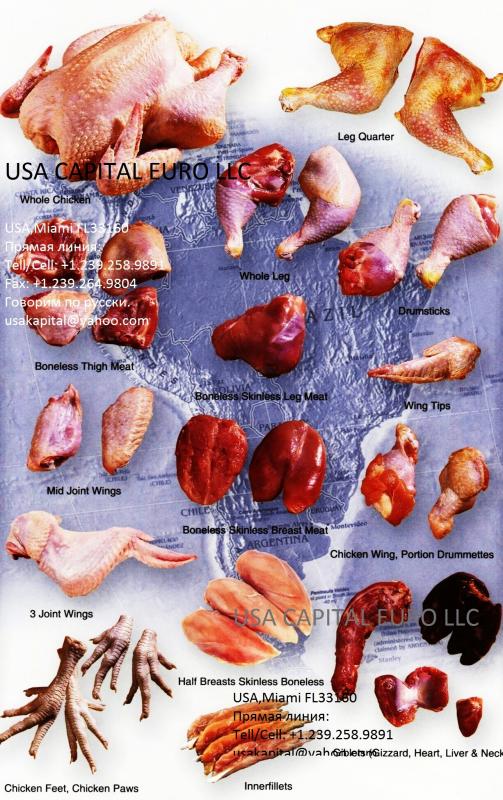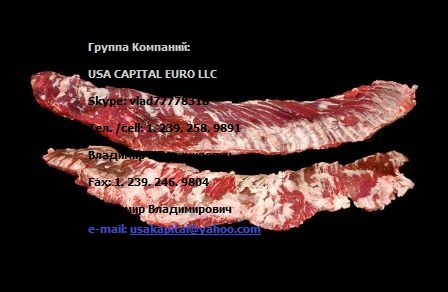Наша Продукция, Мясо, Курятина, США, Бразилия, Аргентина
Наша Продукция, Мясо, Курятина, США, Бразилия, Аргентина
поставки от USA CAPITAL EURO LLC:
1. Свинины, Говядины, Курятины
2. Предоставим Квоты на ввоз мяса на территории стран таможенного союза
Chicken in the United States is a cheap and readily available meat
It is packed in a variety of formats, from whole roasting chickens to selections of one particular cut, such as thighs or wings. Highly automated, large-scale chicken farming and processing complexes run by large corporations fuel the American chicken market. The development of so-called factory farming sharply reduced the price and increased the availability of chicken, when this method was introduced in the 1920s.

Background
The ancestor of today's domestic chicken is the wild red jungle fowl Gallus gallus, native to India and Southeast Asia. The red jungle fowl was first domesticated apparently for use in religious rituals involving cockfighting. The domesticated bird spread west-ward from India to Greece, and was later introduced to Western Europe by invading Roman armies. By the Roman era, chickens were used as food, both for their meat and for their eggs. Romans commonly carried them on their ships, as a convenient source of fresh food.
The first European settlers in North America brought chickens with them. But until the twentieth century, there was no chicken industry as such in this country. Care of the chicken flock was for the most part considered work for women and children. At that time, a typical hen laid only 30 eggs a year, and farm wives sold their excess at market as supplemental income. Chicken meat was usually only plentiful in the early summer, when chickens that had hatched in the spring were big enough to eat. Because chicken husbandry was primarily women's work, only as an adjunct to the major farm production, distribution channels were limited. Whereas railroads were built to bring cattle from the West to waiting urban markets, no such effort was put into chicken production, and chicken was available in cities more or less sporadically, with large seasonal jumps in prices and amount of supply.
Several inventors perfected chicken incubators in the late nineteenth century. These machines could keep hundreds of eggs at a time warm, and so made possible commercial breeding of chicks. In the nineteenth century, breeding of chickens was mostly a hobby, with many poultry enthusiasts raising fabulously feathered chickens. Showy and colorful exotic breeds were the most popular; however, with the advent of mechanical incubators, poultry breeders began to breed birds with good egg-laying and meat production potential.
The first person in the United States to raise broiler chickens (chickens for meat) on a large scale strictly for profit was a Mrs. Wilmer Steele, of Ocean View, Delaware. In 1923, Mrs. Steele bought 500 chicks and sold the surviving 387 of them when they matured to 2 lb (0.9 kg). Her profit was enormous, and within just a few years, Delaware became the center of a thriving chicken industry. In 1926, the state produced around one million broiler chickens.
By 1934, it was raising about seven million chickens annually. In the 1930s, the National Poultry Improvement Plan, a federal-state cooperative mission, helped chicken farmers use scientific breeding principles to produce superior strains of birds. At this time, birds were first bred specifically for meat production. The important qualities of broiler chickens were rapid growth, white feathers (dark feathers left unsightly stubs), and meaty breasts and thighs. The advances in breeding made quite an impact: in 1900, a typical chick took 16 weeks to reach 2 lb (0.9 kg), which was considered frying weight. Today, a commercial broiler chicken lives only about six weeks, and weighs about 4 lb (1.8 kg) at slaughter.
Advances in nutrition were also important to the development of a commercial chicken industry. Chicken nutrition has actually been studied more, and is better understood, than human nutrition. The combined efforts of the feed industry, the U.S. Department of Agriculture, and agricultural scientists led to optimum feed. The ratio of feed necessary per pound of chicken meat has fallen through this century, making chicken ever cheaper to produce. By the 1950s, several large companies had integrated feed production with chicken farming and meat processing, so that only a few large corporations controlled a high percentage of the chicken produced in this country. These major producers each slaughter millions of chickens a week.
Commercial chicken production

The production complex
Chicken production is typically carried out at so-called complexes. Each complex contains a feed mill, a hatchery, a processing plant, and chicken farms where the chicks are raised, usually in a 30-40 mi (48.3-64.4 km) radius from the processing plant. Contract farmers receive chicks from the hatchery, and house them in climate-controlled chicken houses. The houses are typically 400 x 50 ft (122 x 15.24 m), and hold up to 20,000 chickens. The interior is open, with no cages or partitions. When the chickens are old enough for slaughter, they are collected and shipped to the processing plant.
The hatchery
1 Broiler chickens are bred especially for meatiness, quick growth, and weight gain. Most chickens used for meat in this country are a hybrid of Comish males and White Rock females. The hatchery houses a flock of thousands of chickens. The hatchery building is a large open space similar to the house where broilers are raised, except it contains many small houses set inside it, which look like miniature versions of the traditional chicken coop. When the hens are ready to lay, they seek shelter in the coop. The eggs are collected from the coops and taken to incubate. The breeder hens live for about 45 weeks, after which they are no longer considered productive. These "spent" hens are slaughtered and their meat is usually used for pet food or bought by food companies that use cooked, diced meat (such as in soups).
Incubation
2 The eggs are placed in large walk-in incubators. The eggs are kept warm and periodically rotated by machine. They begin to hatch in about 20 days. Shortly before hatching, the eggs are transferred to drawers. Many processors now inoculate chicks for diseases in ovo, that is, in the shell before they hatch. This is usually done three days before hatching. The chicks peck their way out of their shells when they are ready. For their first several days of life, the chicks are still absorbing nutrients from their yolk sacs, so they do not need food at this time. Trays of newly hatched chicks are wheeled on carts to an inoculation area, where they are sprayed with a mist of vaccine against common diseases. Some producers "debeak" the chicks at this point, which actually means clipping the sharp tip off the beak. This prevents the birds from damaging each other by pecking. This practice was discontinued at some large producers in the late 1990s, as for the most part the growing chicks are not overly aggressive, and debeaking was deemed costly and unnecessary. Next, the chicks are shipped to the nearby "grow-out" farms.
Growing out
3 The chicks live in large houses which hold as many as 20,000 birds. These grow-out houses are kept at about 85° F (29.4° C) through heating and ventilation controls. The birds are not caged, and typically they are provided with approximately 0.8 sq ft per bird. The floor of the house is covered with a dry bedding material such as wood chips, rice hulls, or peanut shells. The birds are fed a diet of chicken feed, which is typically 70% corn, 20% soy, and 10% other ingredients such as vitamins and minerals.
Вы всегда можете обратиться к нам напрямую по указанным ниже координатам, мы всегда рады начать долговременное сотрудничество.
Объемы поставок от 50-100 метрических тонн.
Пробные поставки от 25 метрических тонн.
Срок поставки 15-20дней с момента постановки судна на фрахт и оплаты.
--
USA CAPITAL EURO LLC
Tel: +1 239 258 98 91
Fax: +1 239 246 98 04
Skype: expo.invest
e-mail: [email protected]
www// Сайт компании
Создано на конструкторе сайтов Okis при поддержке Flexsmm - купить лайки



